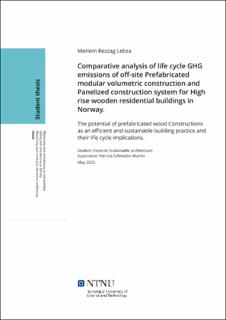| dc.description.abstract | In this report, we will evaluate the development of tall wood and exploring the potential of prefabrication in the construction process of high wooden residential buildings and their Life cycle performance as low carbon construction systems. We will also compare the GHG emissions from two different systems: prefabricated volumetric Modules and Prefabricated building kits (Panelized system). With an initial assumption that Adopting prefabrication may contribute with significant environmental benefits and GHG emission reductions. The greenhouse gas emissions were calculated based on the Life Cycle Assessment (LCA) methodology.
This study sets a calculation boundary and six emission sources for the prefabricated construction process: Production of building materials, transportation of building materials to construction site, transportation of construction waste and soil, Site construction operations, operative energy use and waste and including end of life stage.
The results shows that Modular construction’s total global warming impact is 30% less than a panelized system, and by considering each life cycle stages: the production stage modular system had significant impact with 31% higher carbon emissions than a panelized system (excluding the concrete use), However the Panelized system has a higher mitigation impact on carbon emissions with a 40% reduction in GHG in the transport process .
Modular systems are hightly time efficient for the installation stage as they don't require intensive on-site machinery. Furthermore, the emissions from several prefabricated construction technologies were investigated using reference buildings and a variety of scenarios and assumptions. the results suggest that panelized systems outperform volumetric prefabricated modules in terms of end-of-life advantages and CO2 payback.
Finally , the outcome of this study is influenced by the holistic construction strategy and methodology, such as structures, foundations, and infrastructures. Despite the fact that the popularity of tall timber buildings is on the rise in the construction sector, concrete remains ubiquitous and necessary for structural purposes which means a definitive conclusion would be hard to be drawn from this investigation report on itself as a consequence to the restricted samples and assumptions it is based on. But Modular system seems to be a more efficient construction method compared to panelized system for Timber residential buildings. | |
